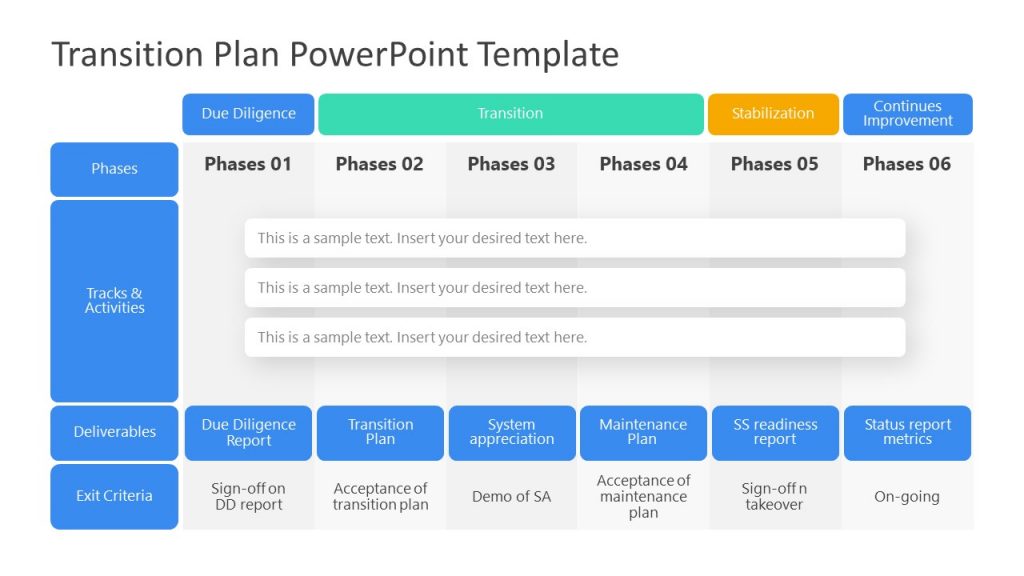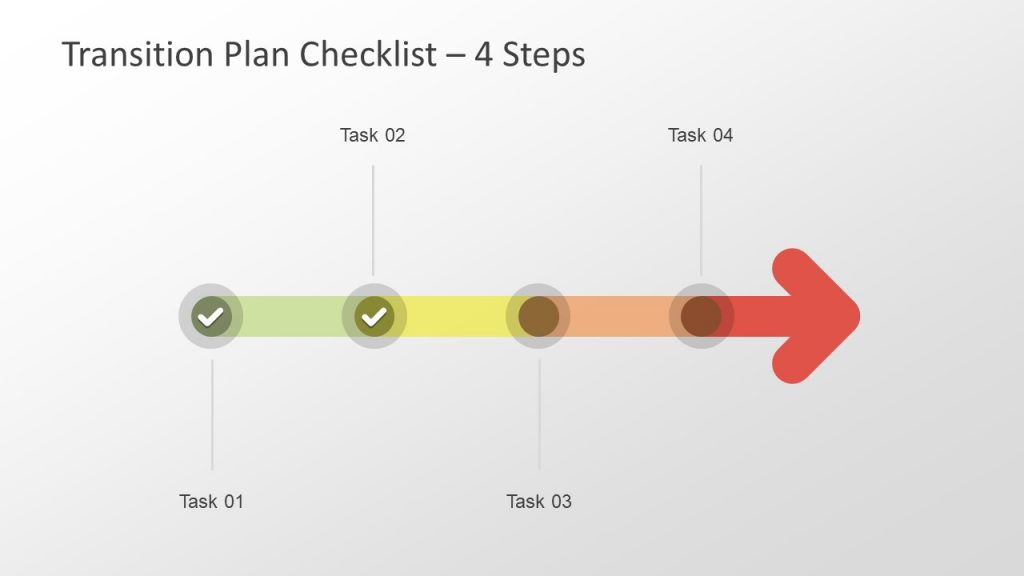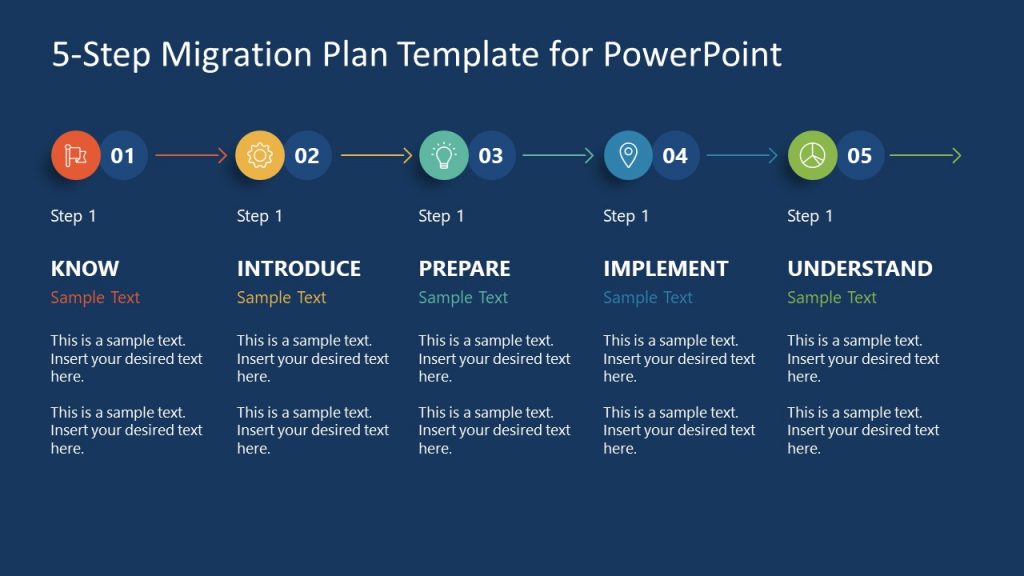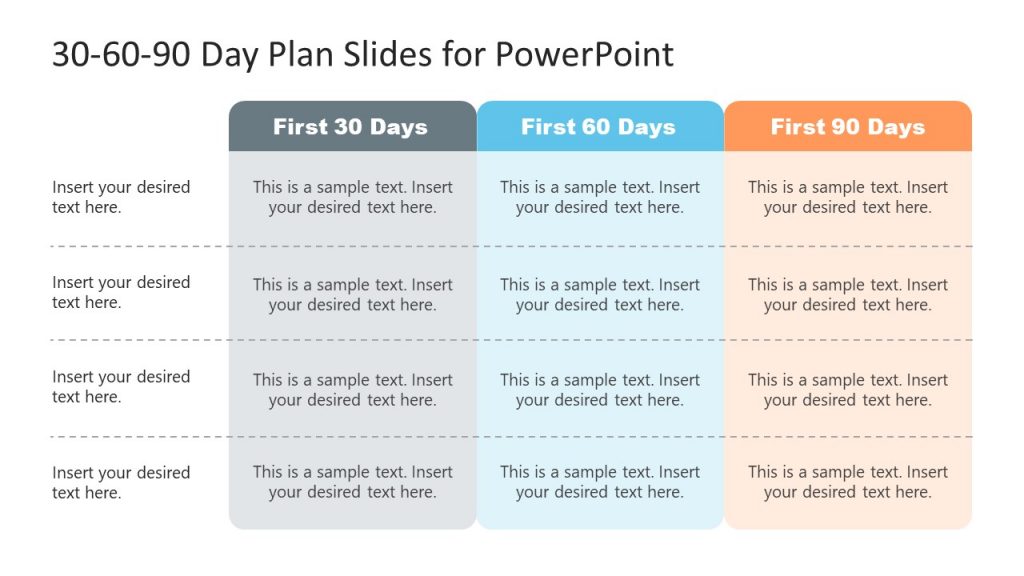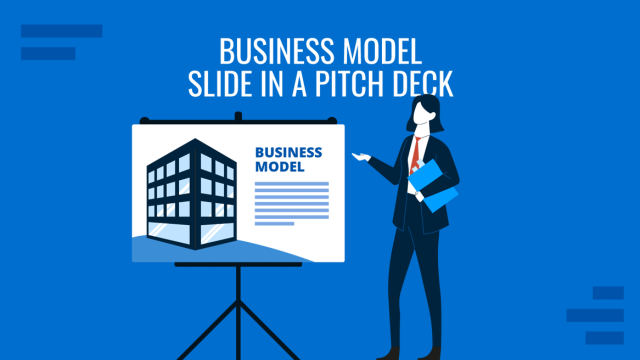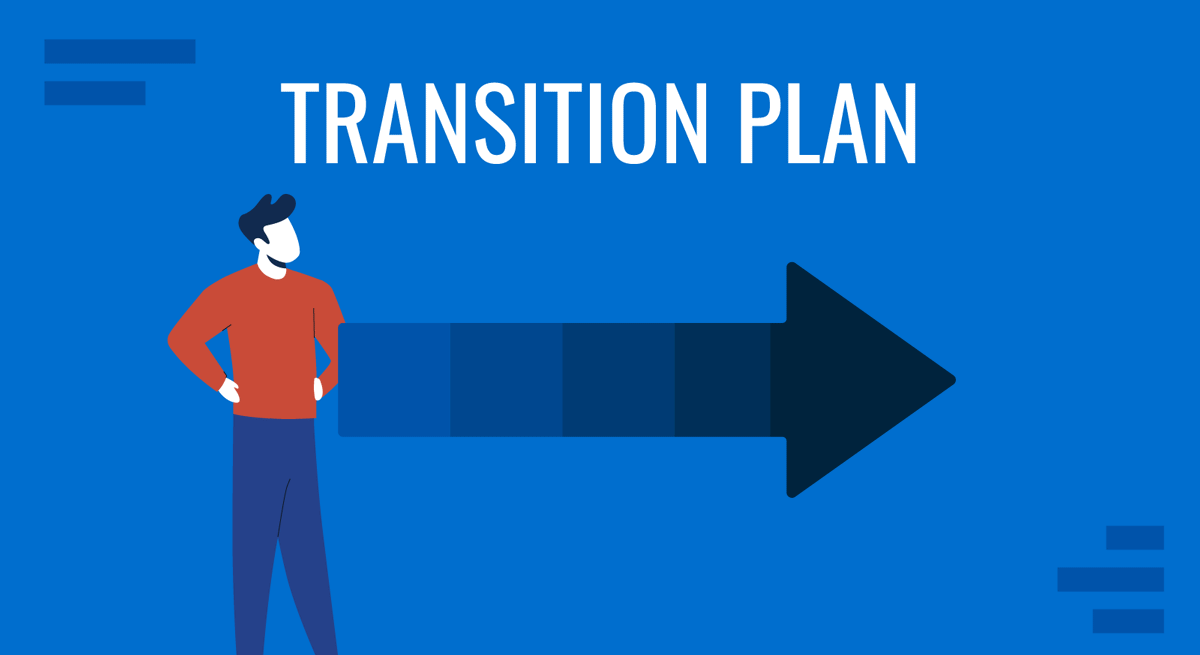
Changes inside an organization can be triggered by both external and internal factors. When we mention external factors, we can picture new competitors or technological advancements, whereas internal factors most likely refer to organizational restructuring or process refinement. Regardless of the scenario, clear communication is necessary to ensure smooth functioning in the organization.
Transition plans play an important role in aligning organizational efforts toward strategic goals. They inform employees of the necessary steps for changes to occur while minimizing friction with the current operations’ expected performance. In this article, we will delve into the elements of a transition plan, guide you on creating a transition plan presentation, and outline the tools required for its execution.
Table of Contents
- What is a Transition Plan?
- What are the Elements of a Transition Plan?
- What are the Types of Transition Plans?
- Importance of the Transition Plan in Businesses
- How to Write a Transition Plan
- What is a Transition Plan Presentation?
- What is Required to Communicate a Transition Plan in a Presentation?
- How to Create a Transition Plan Presentation
- Final Words
- References
What is a Transition Plan?
A Transition Plan (in the context of an employee) is a proactive method for recording and outlining the essential tasks, daily duties, professional connections, and resources held by an individual who will be transitioning out of their role. This documentation ensures a smooth transfer of responsibilities to a temporary backup or permanent successor, minimizing disruption when the individual leaves the position [1].
The transition plan applies to different scenarios where the employee can move inside the organization, leave the organization, or adapt to a new project or procedure. Both supervisors and the successor in the specific role are the target audience of a transition plan.
What are the Elements of a Transition Plan?
We can use the building block metaphor to think of a transition plan. The elements require inputs from different departments or documents, and we can list them as follows:
- Introduction and Overview: The “why” of the transition. It has to clearly state the purpose, its scope, and the overall objectives or goals.
- Stakeholders and Team Members: List all stakeholders and team members, mentioning their roles and responsibilities on ongoing projects.
- Transition Schedule: A detailed task list of all ongoing projects, their milestones, and deadlines. Once that’s completed, we create the timeline for completing activities to secure a successful transition.
- Resource Allocation: Human resources, hardware, software, budget, and financial resources.
- Risk Management: Identify potential risks, develop risk mitigation strategies and contingency plans.
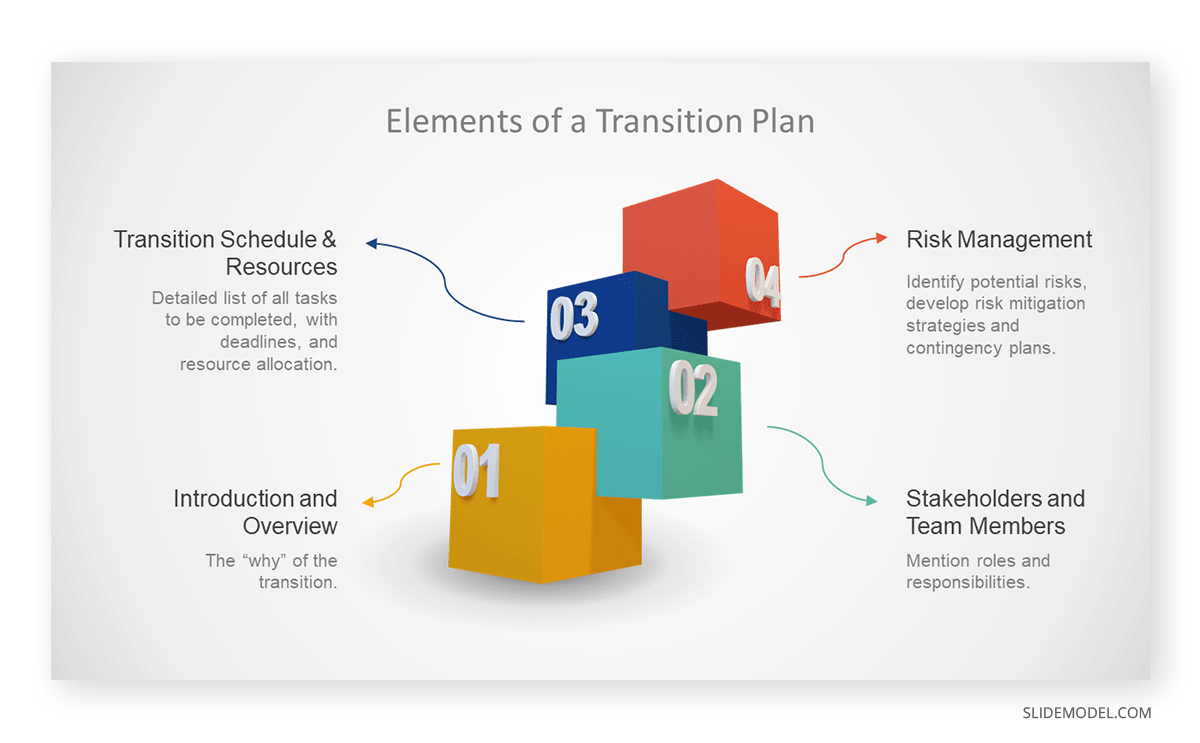
What are the Types of Transition Plans?
Although transition plans are typically considered for employee transition phases, there are multiple scenarios in which transition plans are required.
Employee Transition Plan
Designed for onboarding new employees or in cases where incumbents move into higher seniority roles within the organization. They include training schedules, knowledge transfer, ongoing project status, and role-specific goals.
Project Transition Plan
Required when a project is handed from one team to another or when it changes from one phase to another. We have to list detailed timelines, deliverables, and detailed project history.
Business Transition Plan
The most typical scenario involves mergers or acquisitions, but they are also implemented in organizational restructuring. A business transition plan includes strategic objectives, resource allocation, and communication strategies.
Technology Transition Plan
Required when an organization is rolling out large-scale technology changes (either for software, hardware, or processes). They must include the system integration steps, user training, and data migration procedures.
Client Transition Plan
A client transition plan is required when there’s a need to transfer client accounts or services from one entity to another. We can think of this in situations of mergers and acquisitions, where the client accounts need to be transitioned to the acquiring company. Contractual changes are another situation that requires client transition plans, and so is staff turnover – when a key account manager leaves the organization and their responsibilities must be transitioned to another employee.
Leadership Transition Plan
Used when transitioning leadership roles, like a new CEO or department director. Detailed planning on the succession strategy, stakeholder investment, and strategic alignment are commonly listed among the requirements of this transition plan model.
Career Transition Plan
Finally, this type of transition document can be classified independently, although it’s commonly considered a subset of the employee transition plan model. Career transition plans are used when a person changes their career path, for example: a technical SEO role transitioning into frontend development. They can represent changes between departments, as in the case we just exposed, or inside the same department but for a different technical role.
Importance of the Transition Plan in Businesses
A transition plan is a practical guide for employers and employees during organizational career changes. By developing a structured action plan, both parties gain a clear and achievable outline for navigating career transitions effectively. This strategy helps maintain continuity in crucial business functions and enhances the clarity and confidence of all involved. Here are several key ways in which a transition plan benefits an organization:
Maintains Business Continuity
The plan ensures that the company runs smoothly, without disruptions, even during important projects [3]. This is crucial for maintaining the flow of work and meeting deadlines.
Facilitates Knowledge Transfer
It sets up a system for passing essential knowledge to new and current team members. This transfer is necessary to keep the team well-informed and efficient.
Reduces Uncertainty and Anxiety
The plan highlights each step of a transition. This helps reduce stress and uncertainty for employees and their colleagues moving to a new role.
Boosts Employee Morale
Involving employees in the transition process makes them feel valued and included in decision-making. It boosts their engagement and satisfaction at work.
Prevents Losses and Missed Opportunities
A well-defined plan keeps the organization focused on its objectives, even during significant changes. This focus helps avoid potential setbacks or missed chances.
Saves Time and Resources
Having a clear plan in place during busy times means less scrambling. This helps save time and resources, allowing employees to concentrate on their primary tasks.
Standardizes Procedures
Transition plans create a uniform way to handle the handover of responsibilities when a job becomes vacant, planned or not. This includes setting clear goals, strategies, and priorities and ensuring all duties are noted to prevent any details from being overlooked.
Mitigates Risks
The plan reduces risks to business relationships, particularly related to roles that deal with clients or suppliers [3]. It can also serve as a training guide for backups or successors.
How to Write a Transition Plan
In this section, we will explain the process of writing a transition plan. These instructions will be generic and applicable to all transition plan models, but specifics for each kind of transition plan must be added.
Assessment and Goal Setting
Start by gathering and analyzing the data to understand the organization’s current situation and the necessity for a transition. In this, you are conducting a Needs Assessment study, in which you can implement a SWOT analysis to give a broader picture of where the organization stands.
Goals must be clear, measurable, achievable during the transition period, and aligned with the organization’s mission, vision, and strategic goals. Key stakeholders must be involved in this process to ensure their perspectives and needs are considered. Additionally, you ought to gather input from the departments and teams directly affected by the transition.
Identify Transition Points
The first step is to map out the current processes that will be affected by the transition. Flowcharts and process maps are ideal tools for visualizing the current workflows and easily locating the modifications to be introduced. Determine the start and end points of the transition, as well as any critical phase in between.
Managers must also evaluate the future impact on operations, employees, and stakeholders at each transition point. Depending on the industry, bottlenecks must be addressed with their respective mitigation plans or further studies in areas of concern.
Develop Transition Procedures
Break down the transition into specific, actionable steps. Each step has to be detailed to avoid confusion or resource usage conflicts between departments. For this reason, in our experience, it’s best to create a standard operating procedures (SOPs) document that can be shared as a handout in the presentation.
Review the procedures with stakeholders or consultant parties to ensure the feasibility of the transition plan, then make adjustments based on feedback.
Assign Roles and Responsibilities
Identify all roles required for the transition, including team leaders, project managers, and support staff. The scope of responsibilities for each role has to be included as well.
Conduct a meeting to inform all parties involved of their roles and responsibilities in the transition planning. You can evacuate doubts by providing an FAQ section or hosting a brief question-and-answer session.
Define Activities
List all the activities required to complete the transition. This includes preparation, execution, monitoring procedures, success metrics, and follow-up activities. Each activity must contain a detailed description, including the objectives, procedures, required resources, and expected outcomes.
Once the activities are drafted, we must prioritize them based on importance and urgency. First, focus on the critical path for the transition, then on the peripheral activities required.
Define Timeline
Develop a timeline that includes the schedule for each activity. Project management tools like Gantt Charts are particularly useful for this purpose, especially if overlapping activities are expected. Then, you can present the key milestones from the beginning to the completion of major stages in the transition plan. Each activity must include a deadline.
Prepare Contingency Plans
A risk assessment study is needed to acknowledge the potential issues or obstacles that can impact the transition process for both internal and external factors. Then, teams have to create strategies to mitigate the identified risks, outlining the steps if the risk materializes and/or alternative plans.
Training sessions for risk mitigation readiness must also be included, especially if the organization opts for internal mitigation procedures rather than hiring third-party services. All stakeholders must be informed of the status of the contingency plan, and the document has to be updated after a specific time period.
What is a Transition Plan Presentation?
A transition plan presentation is a communication tool used to inform stakeholders and team members about the strategy, structure, and execution of a transition plan. It can be used in two different instances: board meetings when fine-tuning details for the transition plan or company-wide when communicating the transition plan to the different teams involved and team members.
The primary goal of a transition plan presentation is to bring clarity and alignment toward the transition objectives, understand the roles and responsibilities, as well as inform the timeline for the process and resources required.
If you need a quick method to create a transition plan presentation, check out our AI presentation maker. A tool in which you add the topic, curate the outline, select a design, and let AI do the work for you.
What is Required to Communicate a Transition Plan in a Presentation?
A well-structured transition plan combines good content, appealing graphics, and a professional template.
Content
Companies prepare various types of transition plans depending on the situation. These can include departmental transition plans during restructuring, leadership transition plans for executive roles, and individual transition plans for employees moving to new positions or exiting the company. Each type streamlines the process of change within the organization, minimizing disruptions and maintaining productivity.
The content of a transition plan includes all the essential duties, current projects, project timelines, and contacts associated with a specific position within a company. It records the tasks an employee is responsible for daily and includes ongoing projects they are involved in. Thus, daily operations will not be disrupted when an employee leaves or moves to a different role within the company.
Graphics
Graphics are important in a transition plan because they help make the information clearer and easier to understand. When you use charts, graphs, or diagrams, you can show relationships between tasks, timelines, and responsibilities in a visual way that words alone might not convey as effectively. This visual presentation helps everyone see the big picture at a glance, making complex information more accessible and easier to remember. In short, graphics simplify complex data, enhance understanding, and make it easier for teams to follow the plan effectively.
For instance, you can use visual aids like flowcharts to present the transition process. In comparison, Gantt charts will help you to show the timeline. It will depict when different tasks should be completed and highlight overlapping activities.
PowerPoint Templates
PowerPoint templates are used for making transition plans because they provide a consistent structure that can be quickly followed and understood. Professionally designed layouts help the user save time and effort, as they don’t have to start from a blank slide. Roadmap templates, in particular, allow the presenter to disclose the stages of the transition plan with vivid visual aids.
Transition plan templates also help in terms of building a cohesive slide deck. They are tailored to fit the company’s specific needs or the transition details, thus easily becoming an official communication channel for high-importance information. This structured approach helps everyone involved in the transition process to quickly grasp their roles and responsibilities, the timeline, and other key aspects of the plan, leading to a smoother changeover. Also, check our article about how to add transitions in PowerPoint.
How to Create a Transition Plan Presentation
For this case study, we will consider a mid-sized software development company named TechCo, which has decided to transition its primary application from on-premises to cloud services. The transition aims to enhance scalability, improve performance, reduce costs, and offer better recovery solutions for clients.
Goals of the Technological Transition
We can use multiple approaches to populate the Goals of the Technological Transition slide.
First and foremost, we’ll use a SWOT analysis template to illustrate this case:
TechCo identified the following goals that justify the requirement of a technological transition process:
- Scalability: The application needs to handle increased load and user base without significant infrastructure changes. The organization is pushing a new marketing strategy to reach bigger companies, so improving scalability is necessary.
- Performance Improvement: By leveraging cloud resources, TechCo aims to reduce latency and improve application speed.
- Cost Reduction: Maintaining on-site servers incurs heavy monthly fees, which are often reflected in customers’ subscription plans. For this reason, TechCo wants to migrate to cloud servers and reduce bills to offer more affordable customer pricing.
- Disaster Recovery: Recently, TechCo was a victim of a ransomware attack. They seek to improve their security protocols and offer 24/7 disaster recovery for clients to ensure business continuity.
- Flexibility: Allow easy updates and feature rollouts without compromising the server uptime.
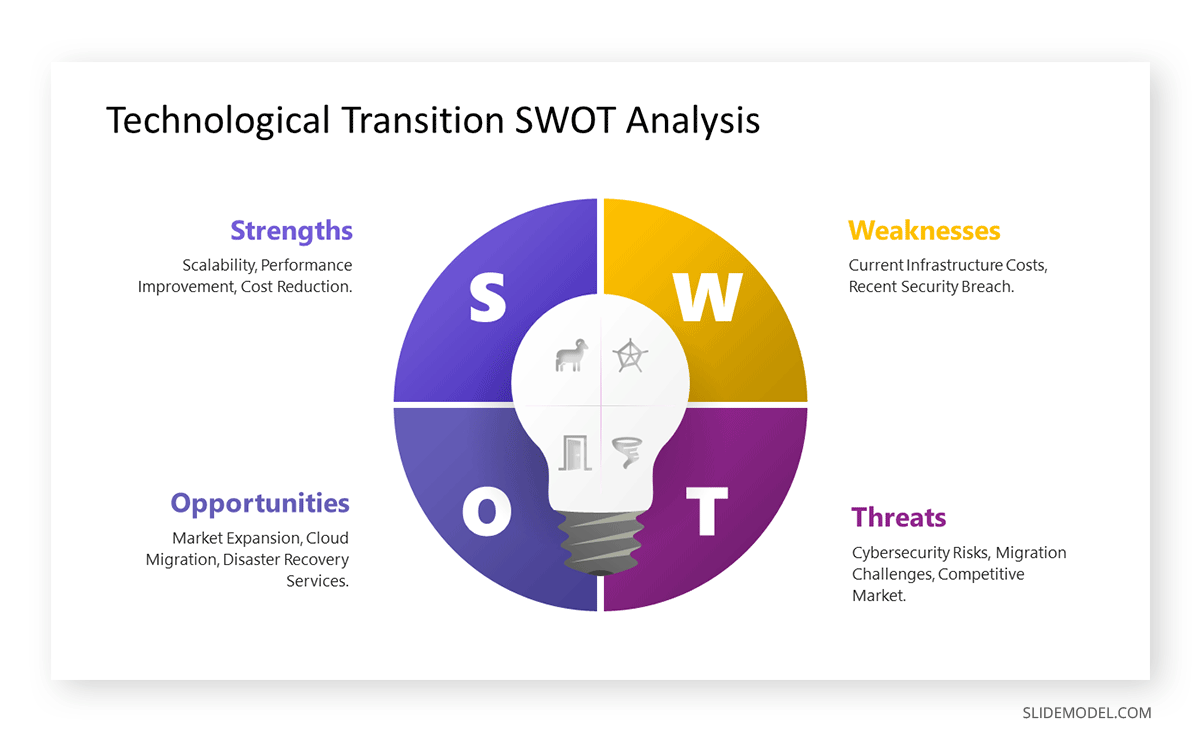
Alternatively, we can represent these previously laid concepts extracted from the SWOT analysis in the format of bullet points with icons, an infographic, or opt for a flowchart that illustrates how an achieved goal turns into a benefit for the organization. Another take is to opt for a Goals & Key Objectives Slide.
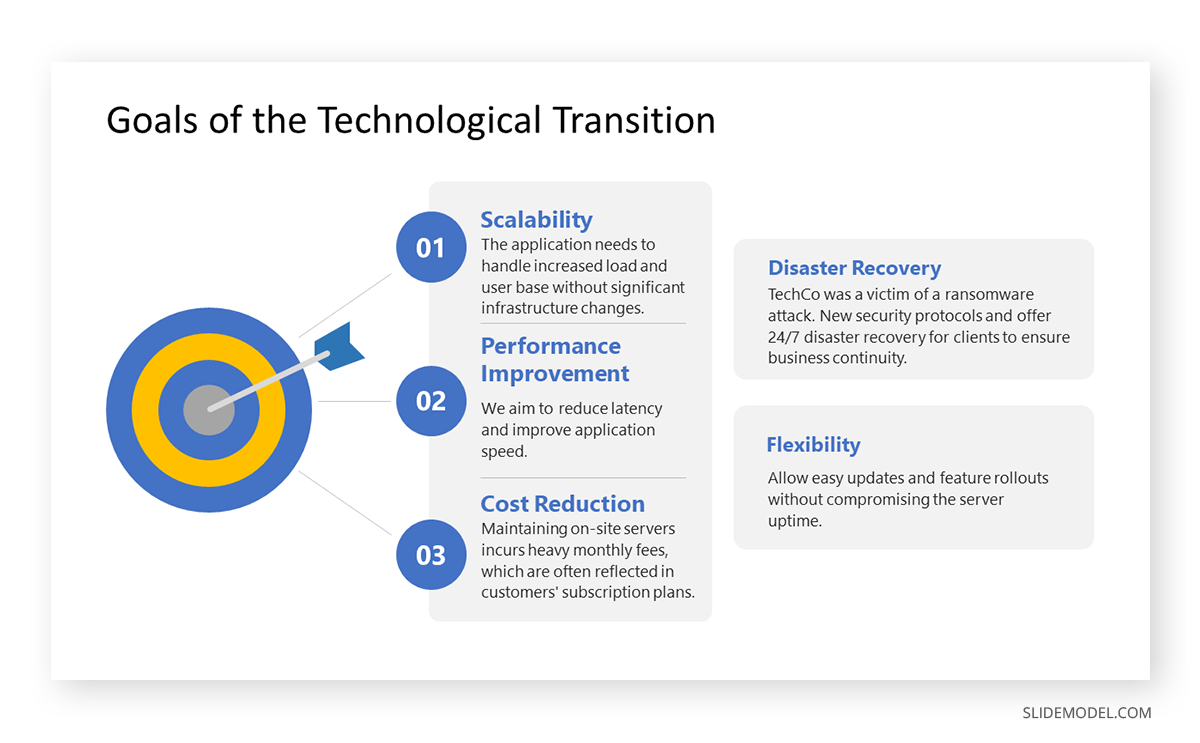
Transition Points
We can consider the Transition Points slide as a checklist of elements that must be completed to ensure the success of the transition plan. For this reason, we will work with the Transition Plan Checklist Timeline PowerPoint Template, which shall be populated with the information below.
There are three main areas of transition for TechCo. First comes the Processes, where data migration from on-premises to the cloud is one point, followed by modifying existing workflows to adapt to the cloud environment. Then we have the People, in which IT staff training and reassignment are required to manage the cloud infrastructure. Finally, we have Software that involves migrating the existing app to the cloud and integrating cloud-based tools and services.
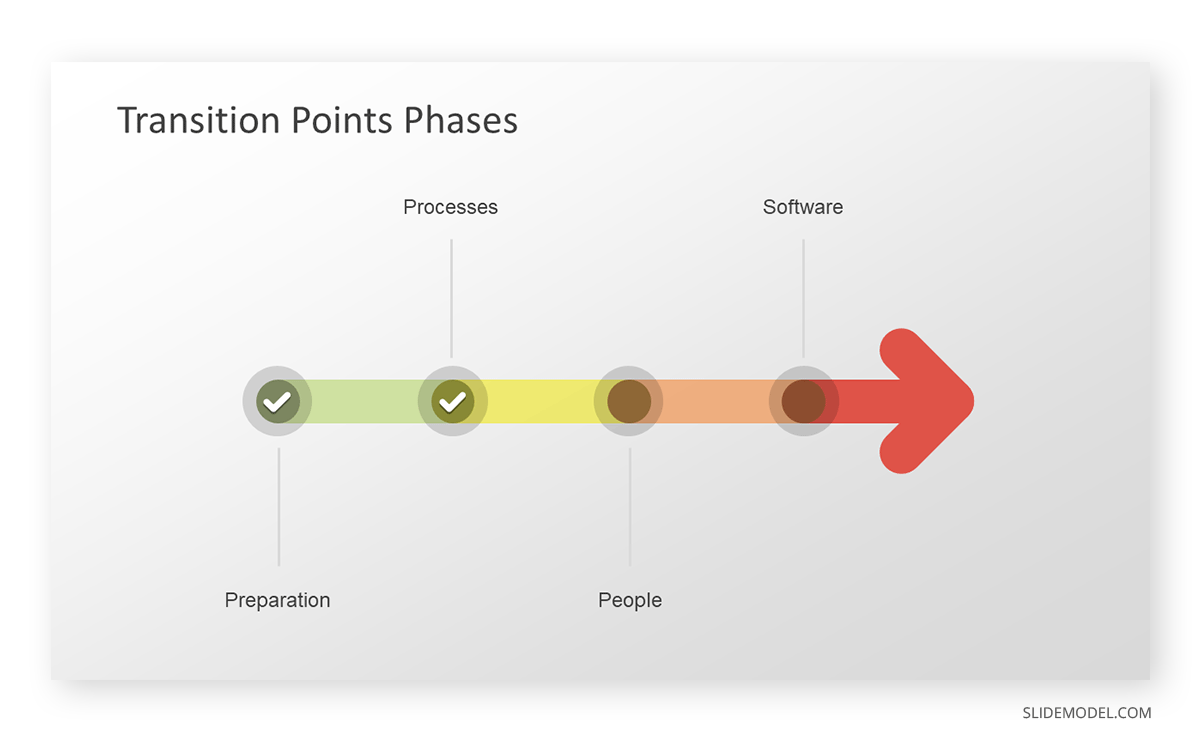
Responsible Parties
In terms of graphical elements, we can work with a Responsibility Matrix to illustrate the roles and to which department they belong in this slide of the transition plan. We will refer once again to the TechCo case study to showcase this point:
To guarantee the success of this technology transition plan, TechCo has to identify the key responsible roles for the process.
- IT Team: They will conduct the transition’s technical aspects, including data migration, software deployment, and system integration.
- Chief Technology Officer (CTO): In charge of overseeing the entire transition process, ensuring alignment with business goals and technology strategy.
- Chief Operating Officer (COO): Coordinates operational changes and manages the resource allocation.
- HR Manager: The person in charge of organizing training sessions and employee transitions between departments.
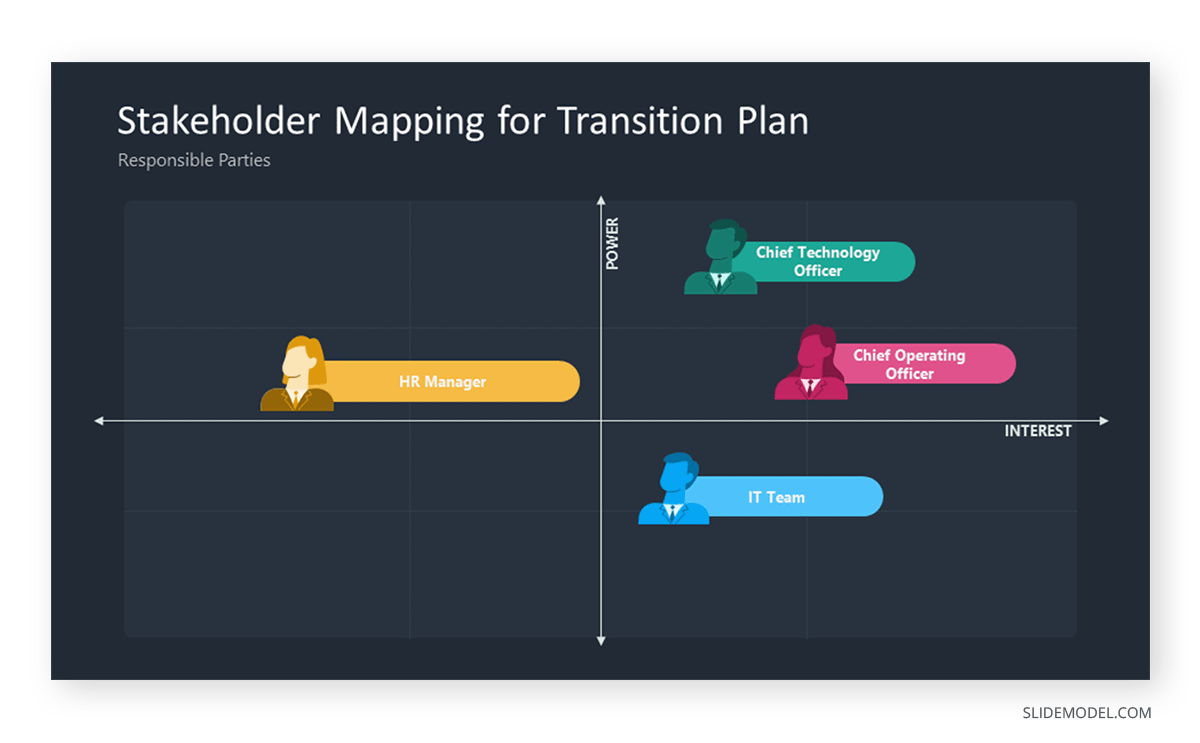
Activities
As mentioned before, the Activities slide describes all the actions that will happen in the transition plan. Process diagrams can be a valid method to present the flow and interconnections between different activities, although one process diagram per slide covering one activity is ideal. Working with all activities inside one process diagram will result in a cluttered slide with little value for the team.
Much like the Transition Points slide, checklists are valid as long as they carefully detail the subpoints inside each activity, meaning the steps to complete each activity. Otherwise, they can become lengthy checklists.
In our case study, we identify six main activities with their respective sub-activities:
- Preparation
- Assess current system
- Select the cloud service provider
- Update existing workflows for cloud services
- Software Migration
- Migrate databases and application files
- Extensive testing to ensure functionality
- Set up parallel on-premise server
- Employee Training
- IT department employee training
- Sales department employee training
- Marketing department employee training
- Feedback from all departments
- Support material/manual creation
- End-User training
- Implementation of the New Version
- Deploy in a secure environment
- Testing phase
- Feedback on test
- Roll-out for end-users
- Stabilization
- Monitoring customer performance data
- Implement a user collaboration program
- Update release to fix bugs
- Operation
- Routine maintenance
- Performance operation
- Customer support service
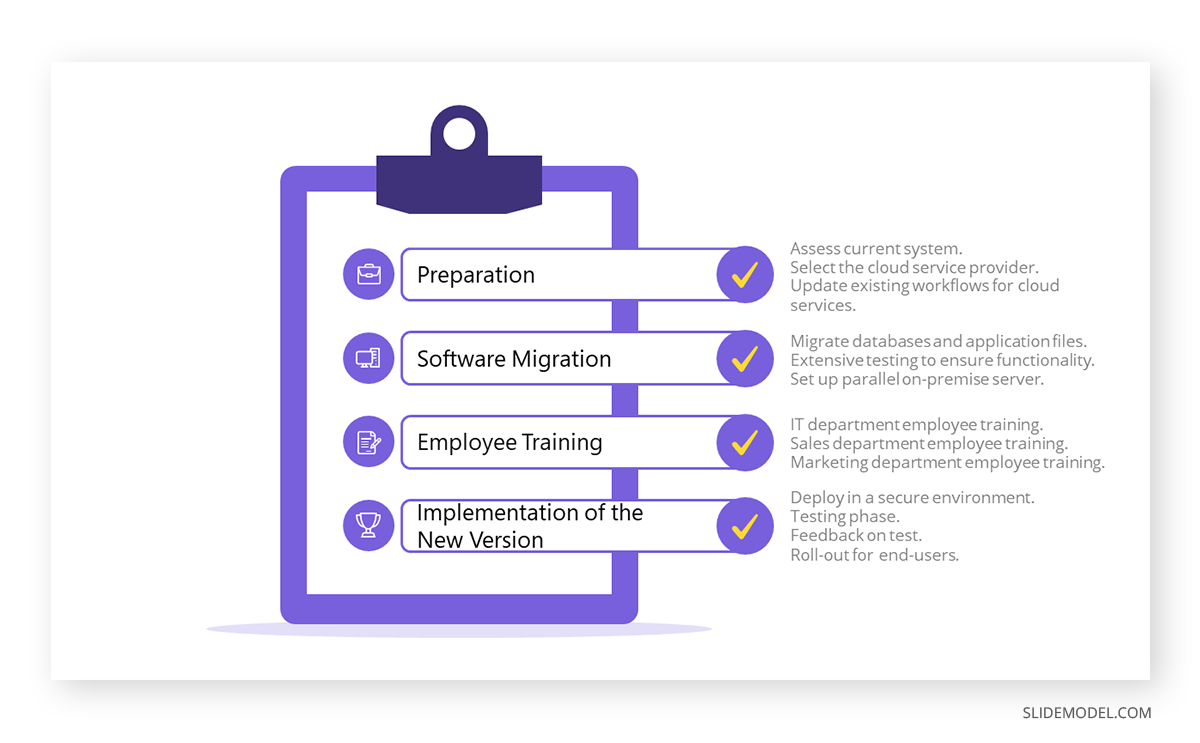
Timeline for the Technological Transition
The total plan will be executed in 10 months. The timeline template below briefly describes the stages of this technology transition plan.
- Month 1-2: Assessment and Planning:
- Conduct system analysis and select cloud provider.
- Develop migration and training plans.
- Month 3-4: Process Modification and Training:
- Redesign workflows and start training programs.
- Month 5-6: Data Migration and Testing:
- Execute data migration and perform extensive testing.
- Month 7: Pilot Testing and Feedback:
- Implement the pilot version and gather user feedback.
- Month 8: Full Implementation:
- Deploy the new version to all users.
- Month 9-10: Stabilization and Monitoring:
- Monitor system performance and address any issues.
- Ongoing: Operation and Maintenance:
- Conduct routine maintenance and provide support.
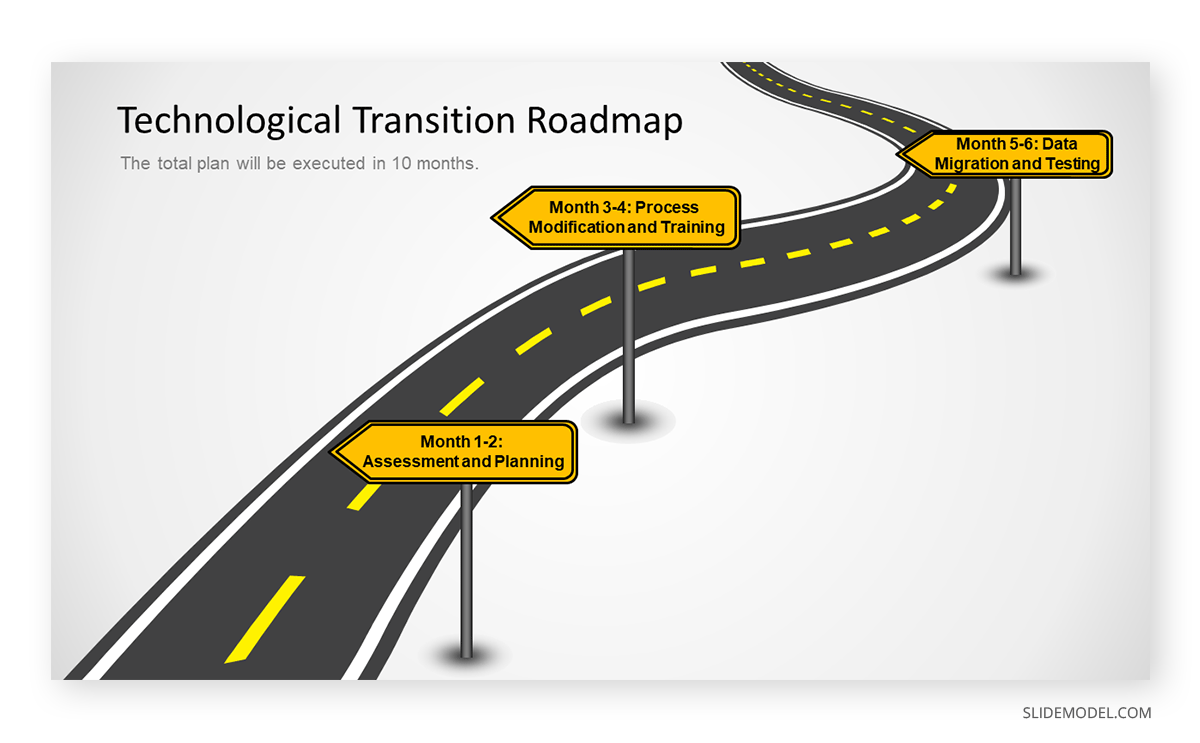
Risks or Contingency
Finally, we have to present both the risks and the contingency plan. For the risk, we can work with a risk matrix and lay out the points that our case study covers:
- Employee Resistance: Due to the drastic technological change, some resistance due to the steep learning curve is expected. The HR team is ready to mitigate any issues by conducting thorough training and maintaining ongoing communication with the marketing and sales department, as they must clearly understand the new app’s performance.
- Missed Stages: When some of the activities are delayed, the “child” activities cannot be initiated, thus delaying the overall transition plan.
- Data Loss: The hefty amounts of data required to be transferred in a transition to cloud services can cause information loss.
- Security Breaches: This is linked to employee training. Strong security measures and protocols must be implemented to prevent cyber attacks on cloud-based servers.
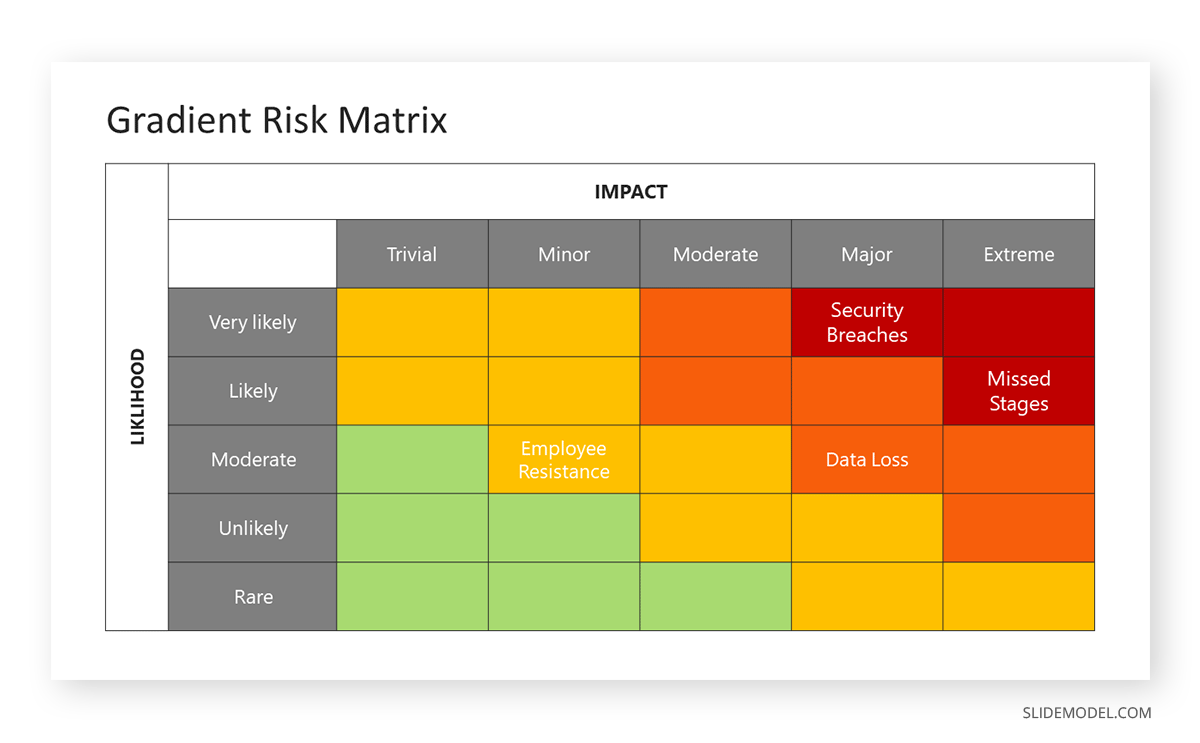
Final Words
Transition plan presentations are a medium to communicate change in organizations, regardless of their scale. We ought to consider this tool as a complementary resource to the written transition plan, as it eases the understanding of complex transition processes. Think of how to start the presentation in an engaging format with an audiovisual element to present the case as clearly as possible.
References
[1] https://dar.uga.edu/wp-content/uploads/Transition_Plan.pdf
